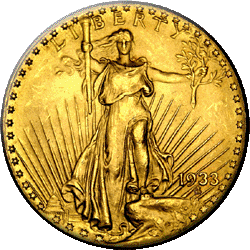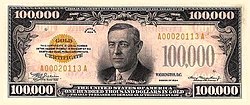Judicial proof - jury or no jury - evidence or no evidence - reasonable doubt is suspended. Lesson learned? Don't trust your government to rule honestly on private citizen gold ownership.These St.G's were minted as general circulating bullion coins, hence the USG must account for them at the official government fixed rate of $42.22 per ounce, each and redeemable at that price only by the US Federal Reserve holding the $100,000 Gold Certificates. Haven't we told you repeatedly that it is CONTROL that matters, NOT Ownership!
Related: Judge To Family "All Your Gold Are Belong To US"

The 1933 Saint-Gaudens double eagle, named after its designer Augustus St. Gaudens, is "one of the most sought-after rarities in history," according to the U.S. Mint.
Though the double eagle was
originally valued at $20, one such coin that belonged to King Farouk of
Egypt sold for more than $7.5 million at a Sotheby's auction in the
summer of 2002, making it the most valuable coins ever auctioned at the
time.
The Philadelphia Mint struck 445,500 double eagles at the height of the Great Depression, but it pulled them back weeks later as President Franklin D. Roosevelt ordered U.S. banks to abandon the gold standard.
With most 1933 double eagles having been melted into gold bars, the Smithsonian was thought to have the only two coins left in existence.
It was eventually discovered, however, that Philadelphia Mint cashier George McCann spirited some away to local coin dealer Israel Switt.
In 2003, Switt's daughter and two grandsons - Joan, Roy and David Langbord - drilled open a safety deposit box. Inside that box, nestled among Switt's belongings, sat a gray paper Wanamaker's department store bag.
That bag contained 10 of the 1933 double eagles, wrapped in tissue paper.
After the Langbords handed over the coins to the Mint for authentication, the government seized the coins and stashed them in a vault at Fort Knox without compensating the family.
In July 2011, the Langbords tried to convince a federal jury that the coins could have escaped the Mint legitimately through a "window of opportunity" between March 15 and April 5, 1933.
The government's star expert, David Tripp, acknowledged gold coins could have left the Mint during that window, but he added that there were no records that 1933 Double Eagles did.
Jurors found that the coins were forfeited to the government, and U.S. District Judge Legrome Davis Jr. refused to disturb the verdict Wednesday.
"In the end, Tripp admitted on cross examination that there was a small 'window of opportunity' during which gold coin was authorized to be released from the Philadelphia Mint," Davis wrote. "And many gold coins did, in fact, leave the Mint during this period of time. ... But as Tripp correctly noted, the Mint records reflect that no 1933 Double Eagles were part of those transactions."
Nobody witnessed the disappearance of the 10 coins, but the jury "could - and did - properly infer criminal intent," he added.
"Not surprisingly, the jury in this case heard no testimony from anyone who was actually present at the Mint when the '33 Double Eagles first disappeared so many years ago - all the primary actors who might have told that tale have passed away," the 54-page order states. "But that certainly does not doom the Government's case because 'explicit evidence is not required to support a finding of specific intent.'"
Absent records surrounding the '33 Double Eagles speak to criminal intent.
"The Mint meticulously tracked the '33 Double Eagles, and the records show that no such transaction occurred," Davis wrote. "What's more, this absence of a paper trail speaks to criminal intent. If whoever took or exchanged the coins thought he was doing no wrong, we would expect to see some sort of documentation reflecting the transaction, especially considering how carefully and methodically the Mint accounted for the '33 Double Eagles.
Source>> Courthouse News Service
Related: Judge To Family "All Your Gold Are Belong To US"
$100,000 bill
The largest denomination of currency ever printed by the Bureau of Engraving and Printing (BEP) was the $100,000 Series 1934 Gold Certificate featuring the portrait of President Wilson. These notes were printed from December 18, 1934 through January 9, 1935 and were issued by the Treasurer of the United States to Federal Reserve Banks only against an equal amount of gold bullion held by the Treasury Department. The notes were used only for official transactions between Federal Reserve Banks and were not circulated among the general public.[4]
(CN)
- A federal judge awarded the U.S. government ownership of 10 rare gold
coins valued at roughly $80 million that have been missing for decades.
The 1933 Saint-Gaudens double eagle, named after its designer Augustus St. Gaudens, is "one of the most sought-after rarities in history," according to the U.S. Mint.
 |
King Farouk of Egypt |
The Philadelphia Mint struck 445,500 double eagles at the height of the Great Depression, but it pulled them back weeks later as President Franklin D. Roosevelt ordered U.S. banks to abandon the gold standard.
With most 1933 double eagles having been melted into gold bars, the Smithsonian was thought to have the only two coins left in existence.
It was eventually discovered, however, that Philadelphia Mint cashier George McCann spirited some away to local coin dealer Israel Switt.
In 2003, Switt's daughter and two grandsons - Joan, Roy and David Langbord - drilled open a safety deposit box. Inside that box, nestled among Switt's belongings, sat a gray paper Wanamaker's department store bag.
That bag contained 10 of the 1933 double eagles, wrapped in tissue paper.
After the Langbords handed over the coins to the Mint for authentication, the government seized the coins and stashed them in a vault at Fort Knox without compensating the family.
In July 2011, the Langbords tried to convince a federal jury that the coins could have escaped the Mint legitimately through a "window of opportunity" between March 15 and April 5, 1933.
The government's star expert, David Tripp, acknowledged gold coins could have left the Mint during that window, but he added that there were no records that 1933 Double Eagles did.
Jurors found that the coins were forfeited to the government, and U.S. District Judge Legrome Davis Jr. refused to disturb the verdict Wednesday.
"In the end, Tripp admitted on cross examination that there was a small 'window of opportunity' during which gold coin was authorized to be released from the Philadelphia Mint," Davis wrote. "And many gold coins did, in fact, leave the Mint during this period of time. ... But as Tripp correctly noted, the Mint records reflect that no 1933 Double Eagles were part of those transactions."
Nobody witnessed the disappearance of the 10 coins, but the jury "could - and did - properly infer criminal intent," he added.
"Not surprisingly, the jury in this case heard no testimony from anyone who was actually present at the Mint when the '33 Double Eagles first disappeared so many years ago - all the primary actors who might have told that tale have passed away," the 54-page order states. "But that certainly does not doom the Government's case because 'explicit evidence is not required to support a finding of specific intent.'"
Absent records surrounding the '33 Double Eagles speak to criminal intent.
"The Mint meticulously tracked the '33 Double Eagles, and the records show that no such transaction occurred," Davis wrote. "What's more, this absence of a paper trail speaks to criminal intent. If whoever took or exchanged the coins thought he was doing no wrong, we would expect to see some sort of documentation reflecting the transaction, especially considering how carefully and methodically the Mint accounted for the '33 Double Eagles.
The jury saw no record of a legitimate '33 Double
Eagle release, and from this lack of documentation one may reasonably
infer that the responsible party appropriated the coins in secret,
knowing full well the wrongfulness and illegality of his actions.
Source>> Courthouse News Service

